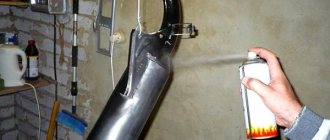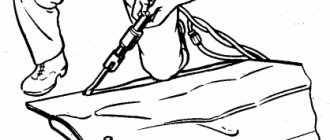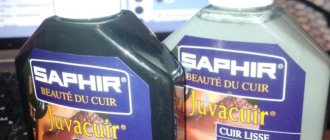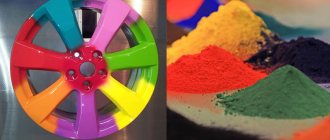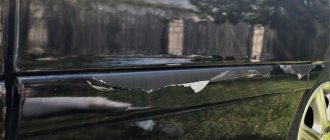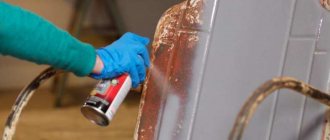Today, each of us, sooner or later, is faced with the need to paint some plastic parts. After all, we are surrounded by many things made of this material: in modern cars, motorcycles and scooters, the number of plastic parts is constantly increasing. The technology of painting plastic has its own characteristics and nuances. This is due to certain properties of this material: it is quite elastic and paint does not adhere well to its surface. Also, the behavior of plastic when coated with paintwork materials depends on the type of plastic. Today, there are a variety of means for coloring this material, so repairing car plastic parts is not a problem.
Painting plastic
The type of material is always indicated in the markings on the inside of the part, so before you start painting, carefully study this abbreviation.
Rules for painting plastic
It should be noted that not all types of plastic lend themselves equally well to coloring. For example, if a material such as polypropylene or polyethylene was used for manufacturing, high-quality painting becomes impossible.
Before painting ABC plastic, before carrying out a set of measures, it is necessary to carry out priming.
Many citizens are wondering whether there is a need for priming.
To have an accurate idea, you need to pay attention to the following aspects:
- If the plastic sinks in water, then there is no need for priming, but if not, priming is mandatory;
- It is also permissible to set fire to part of the part, and if black smoke does not emit during its combustion, it is necessary to carry out priming.
What kind of plastic can be painted?
Before painting plastic, you need to understand whether such an update is possible or not. After all, not every type of this material can be painted.
It will not be possible to visually distinguish one type of plastic from another; to do this, you need to find the marking on the item itself. The following types of material are suitable for the job: ABS and PVC; painting plastic will be successful, but it will be necessary to prime the surface before applying paint.
Plastic car parts can usually be painted; most often the priming step is skipped. But first make sure whether it is necessary to apply a primer to the material, the determination is as follows:
- The product is immersed in water; if it floats up, the surface must be primed;
- Set a small area on fire and look at the flame; if black smoke appears, then there is no need to treat it with a primer mixture.
It will not be possible to visually distinguish one type of plastic from another; to do this, you need to find the marking on the item itself.
Features of painting plastic with your own hands
It is extremely important to take into account that when painting, certain rules must be followed, the main ones being the following:
- It is necessary that the plastic is cleaned and dry;
- The plastic must first undergo a priming process (based on rubbing or spraying). Only after the primer has completely dried should you begin the process of painting it.
In order for the paint to dry well and adhere, it is extremely important to follow the rules, the main ones of which are:
- Painting should be carried out only if the humidity is at least 80% and the air temperature is at least +18;
- Both the dye and the plastic surface must be at the same temperature;
- The paint layer should be of medium thickness, since the drying process of a version that is too thick occurs over a long period, and one that is too thin will crack very quickly;
- The complete drying process takes, on average, about 5 days: the lower the temperature and the higher the humidity, the longer the drying takes;
- For painting soft plastic, it is more acceptable to use elastic enamels, which contain a plasticizer that prevents the corresponding layer from cracking;
Painting hard plastic must be done using acrylic paints.
Expert advice
Expert advice can help make the process simpler and easier. When working with a brush, there are several important nuances: it does not need to be immersed entirely in the coloring composition, only the tip can be immersed; the layer should be made thin, reduction is done by pressing; The slope of the brush remains the same over the entire surface.
The layer should be made thin, reduction is done by pressing.
The article described in detail how to properly paint plastic. Here it is important to choose a paint and varnish that is suitable for the material. Thanks to modern technologies, a large number of paints are produced that will help you get a durable result that looks beautiful in appearance.
Tools and materials for painting plastic
To paint a plastic surface, you must acquire the following items:
- Paints for plastics;
- Acrylic varnish (the best option, in aerosol form), which will be applied at the final stage of the work;
- Special protective equipment, for example, a respirator and goggles; if possible, it is necessary to carry out a set of relevant works on the street;
- Newspapers and films used to protect objects that cannot be painted;
- Paper or masking tape;
- Bucket of water and detergent;
- Alcohol or solvent.
- Sandpaper;
- Putty or primer material.
Painting step by step
If they work with a brush, then they move with different levels of pressure, at first they make it weak, then stronger, in order to create a thin layer. The strokes are made wide and even. Usually 1 layer of brushing is enough.
Using an aerosol involves applying the composition in 2-3 layers. The distance from the object to the can should be left at 20-30 cm. We hold it straight and treat the entire surface in this way, each layer is applied only after the previous one has completely dried. Drying time varies by brand and can be determined by reading the directions on the package.
Next, you can apply varnish to the dried paint in the same way.
Using an aerosol involves applying the composition in 2-3 layers.
Main types of paints for plastic
Initially, it should be noted that painting a plastic surface should never be done using paint containing acetone. As for other options, the most acceptable among them are:
- Water-based paints;
- Matte paints;
- Aerosol paints.
Each of these options has its own characteristics that must be taken into account when painting.
Specifics of water-based paints
Many people call this type of material acrylic enamel. Its main components are a hardening agent and a hardener. The main advantage of this option is durability.
The plastic coating treated in this way does not fade over a long period and is not destroyed under the influence of ultraviolet radiation.
Before starting work there is no need to carry out priming, it is enough to just clean the surface well. This option is suitable only for external use.
Matte paint for plastic
To give the surface an aesthetic appearance, it is extremely important to use matte paint, before using which the surface must be treated with a primer.
This type of paint contains substances that are prone to wear resistance, which makes them suitable for painting cars.
Aerosol paints for plastic
It should be immediately noted that this option is excellent for those who independently carry out painting work.
The following types of aerosols are currently distinguished:
- Soft touch - after all the necessary actions have been carried out, the surface acquires a pleasant roughness; Also, with the help of this paint it is possible to eliminate existing shortcomings;
- Modal enamel provides a glossy shine to the treated surface.
The main advantages of the spray can be considered:
- No costs associated with the purchase of painting materials (for example, brushes and rollers);
- Ease of application;
- Uniform surface coverage and creation of a smooth layer;
- Creation of any texture;
- Preservation and protection from tarnishing for a long period of time;
- Economical paint consumption;
- Ease of painting surfaces of a different color.
Regardless of what type of paint is chosen, to give the surface an ideal look, after drying it must be coated with polishing wax paint, which will help hide minor defects.
In the event that an independent dyeing process is carried out for the first time, it is extremely important to first obtain comprehensive consultation from a specialist.
Surface preparation
Even if you know what paint to paint plastic with, that's not all. It must be properly prepared.
First of all, the plastic is dismantled and then disassembled into its component parts. Steel screwdrivers are not acceptable. Only special blades made of polyurethane. All parts are laid out on a soft surface - sheets of cardboard, chipboard. You should not use fabrics for these purposes - even the smallest lint can ruin the whole thing.
To avoid confusion during reassembly, the bolts and nuts are placed in separate boxes and labeled. When disassembling complex units, you can take photos of the initial state and individual stages.
Then the plastic must be degreased with white spirit, anti-silicone, gasoline or another type of solvent. Small irregularities and chips are repaired using putty. It is better to first smooth out large cracks and cracks with sandpaper and then fill them with sealant. To avoid scoring, use fine sandpaper first, and then coarse-grain sandpaper.
To improve adhesion, the plastic is matted - rubbed with fine sandpaper up to No. 180. To avoid dust, it is better to do this in water. After removing dust and drying, the surface is degreased again.
The last stage is coating with a primer. Without it, the paint will quickly crumble. The primer is applied in as thin layers as possible three times, drying well each time. To avoid drips, use aerosols or a spray gun.
